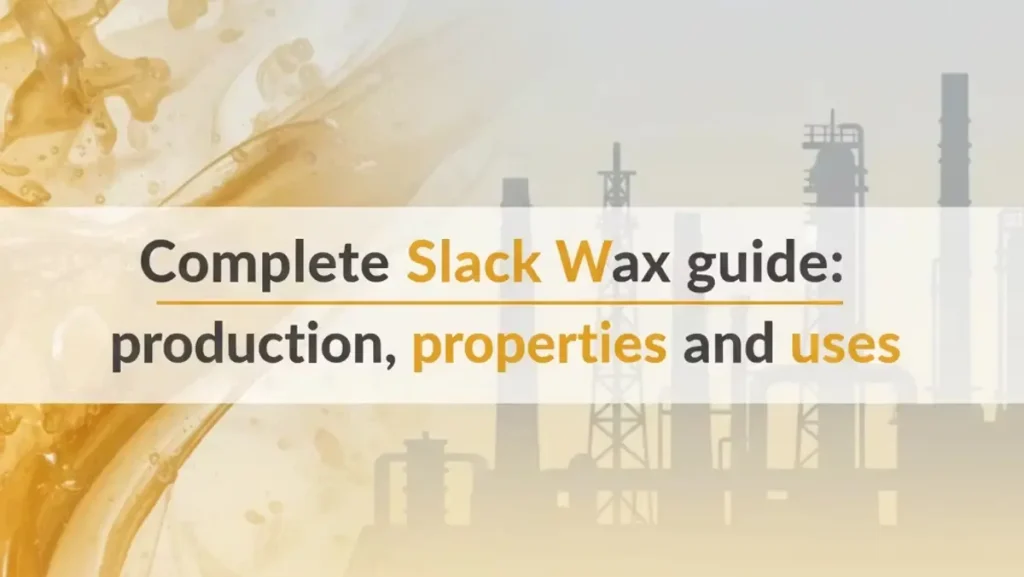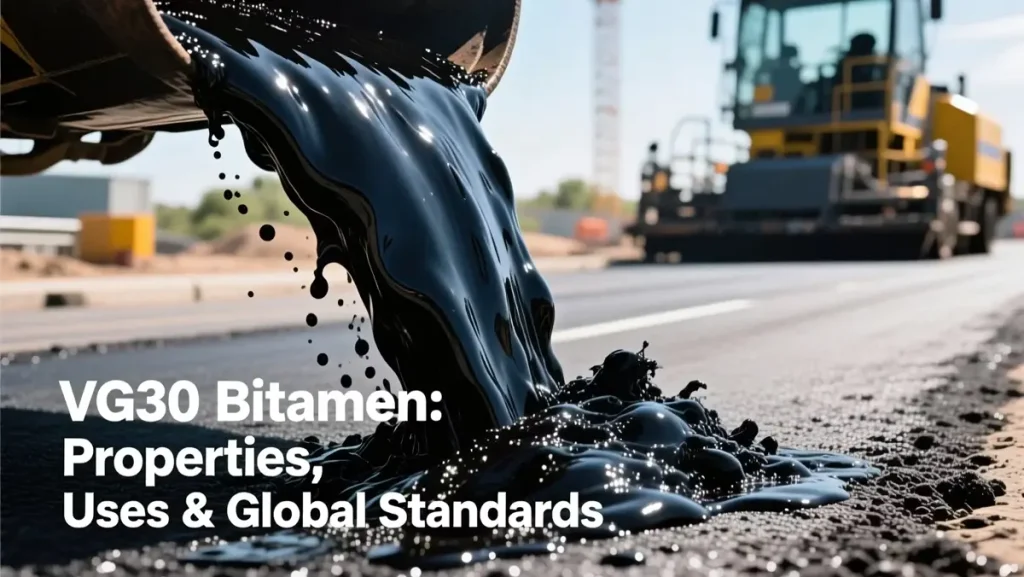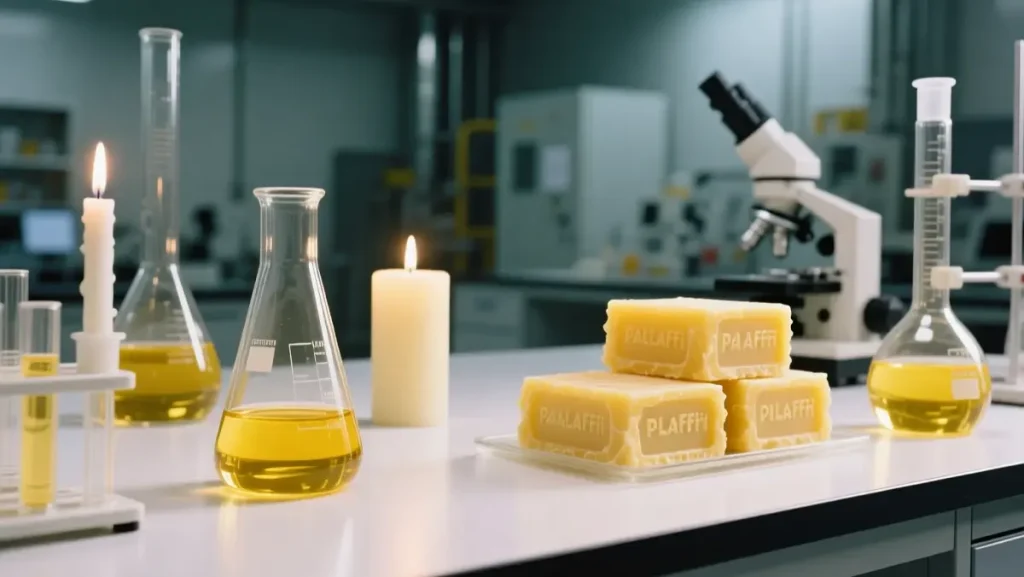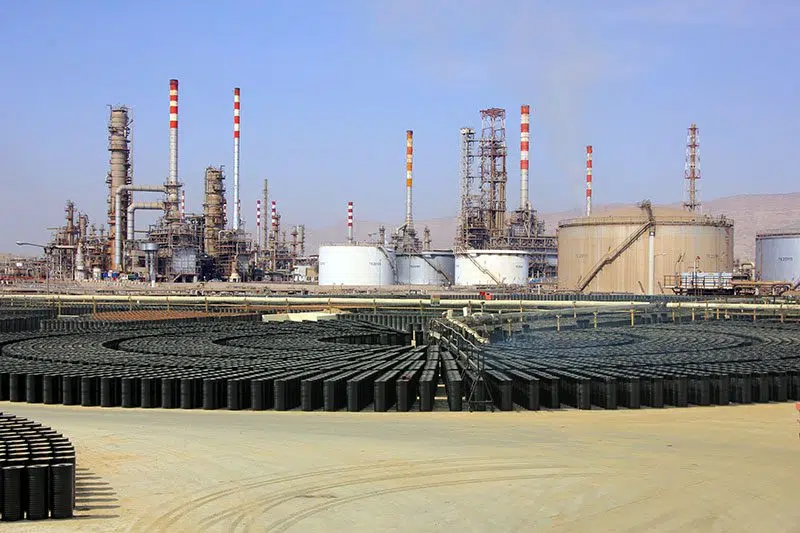Slack Wax is a semi‑refined petroleum wax produced as a byproduct during the de‑waxing stage of base oil manufacturing. It contains long‑chain hydrocarbons with an oil content ranging from 5% to 35%, giving it a softer texture than fully refined paraffin. Widely used as a feedstock for refined waxes and in industries such as candle making, rubber processing, and waterproof coatings, Slack Wax plays a crucial role in industrial production efficiency and environmental performance. Understanding its composition and refining process is essential for achieving high‑quality and sustainable wax solutions.
Chemical Composition of Slack Wax
The chemical composition of Slack Wax defines its physical behavior, refining quality, and final applications. It mainly consists of two components: solid waxes and mineral oils, alongside small amounts of impurities.
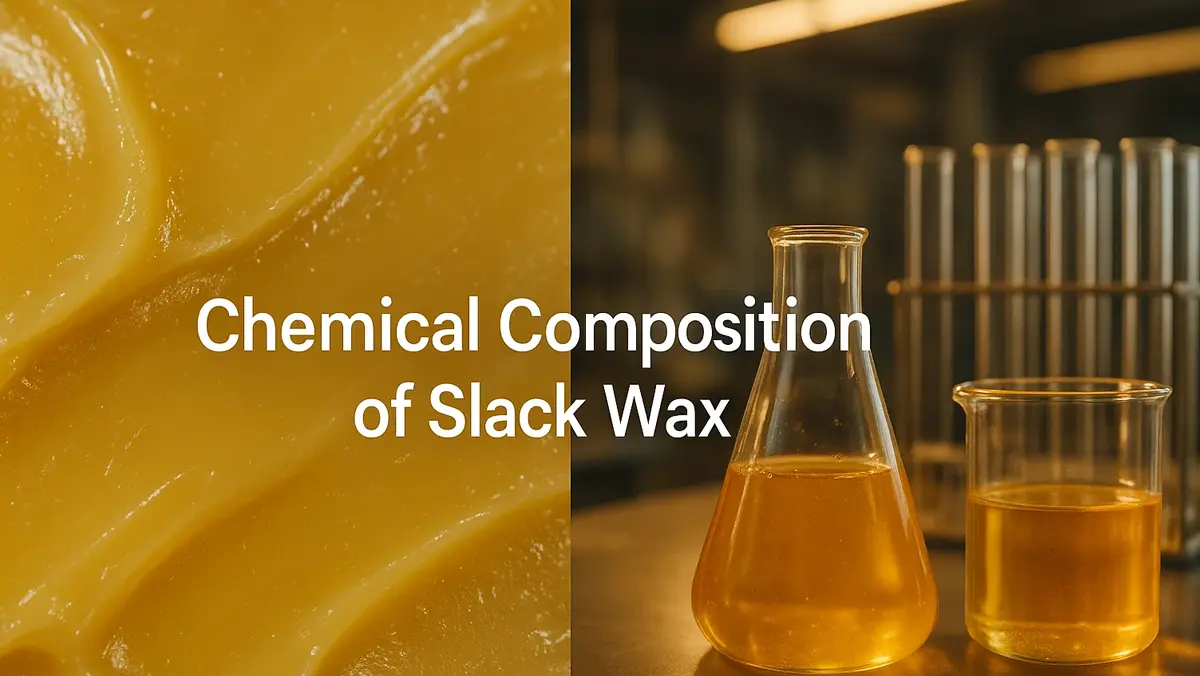
Main Components
- Solid waxes: Long‑chain saturated hydrocarbons, typically n‑paraffins and iso‑paraffins. They provide the solid structure and melting characteristics of Slack Wax.
- Mineral oils: Lighter hydrocarbon fractions, making up between 5% and 35% of the total weight. These oils give Slack Wax its semi‑soft texture and lower melting point.
- Impurities: Trace levels of sulfur, nitrogen, oxygen compounds, and occasionally metal residues, depending on the crude oil source and refinery type.
Additional Specifications
- CAS Number: 64742‑61‑6
- Average Melting Point: 43°C to 63°C
- Hydrocarbon Chain Length: C20–C60
- Oil Content: 5%–35%
Due to this composition, Slack Wax behaves as a mixture of crystalline and oily phases, where the balance between these two determines its quality grade. A higher oil content results in a softer product, while lower oil content produces a firmer grade suitable for paraffin conversion.
Industrial Production Process
The industrial production of Slack Wax takes place during the de‑waxing stage in lubricant base oil manufacturing. In this process, waxes are separated from crude oil fractions to improve the fluidity of base oils. Slack Wax naturally forms as a byproduct of this separation.
Main Stages of Production
- Solvent De‑waxing: Base oil feedstock is mixed with solvents such as methyl ethyl ketone (MEK) and toluene. These help separate crystallized wax from oil at controlled temperatures.
- Separation and Solvent Recovery: The mixture is filtered or centrifuged to remove wax crystals. Then, solvents are recovered and reused in a closed‑loop system, improving resource efficiency.
- Hydro‑processing and De‑oiling: Slack Wax may undergo mild hydrogenation or de‑oiling to reduce impurities and lower sulfur compounds. This step produces cleaner, higher‑purity wax suitable for industrial and cosmetic applications.
- Global Refining and Distribution: Refineries in North America, Europe, and Asia (iran) process and ship Slack Wax in various grades. Transportation and packaging are designed to preserve its viscosity and prevent contamination.
Modern Refining Efficiency (2025 Focus)
In recent years, refineries have moved toward energy‑efficient systems and solvent recycling technologies, which reduce emissions and operational costs. Automation and AI‑based process control have become common, ensuring consistent product quality and sustainability.
Slack Wax produced by solvent de‑waxing remains an essential intermediate in wax refining and lubricants production. The process determines the purity, color, and oil content that classify each grade used worldwide.
Physical Properties & Classification
The physical properties of Slack Wax are directly related to its composition and oil content. It exists as a semi‑solid material at room temperature and varies from light yellow to dark brown depending on its grade and source of crude oil.
General Physical Characteristics
- Melting Point: 45°C to 68°C
- Consistency: Semi‑solid or soft wax at ambient conditions
- Color: Yellow to brown; lighter grades indicate lower oil levels
- Oil Content: 5% to 35% depending on type
- Viscosity: Higher oil content increases viscosity and reduces hardness
Because of these characteristics, Slack Wax behaves differently in various industrial settings. The product’s softness makes it suitable for lubrication and coatings, while firmer grades are preferred for paraffin wax conversion.
Classification by Oil Content
Slack Wax grades are commonly divided into two categories: light and heavy, based on their oil percentage.
A higher oil content generally results in a softer and darker material, while lower oil content makes the wax firmer and more solid.
| Property | Light | Heavy |
|---|---|---|
| Oil Content | 5–10% | 25–35% |
| Color | Light yellow | Brown |
| Consistency | Soft | Sticky/semi‑liquid |
| Applications | High-purity wax refining | Waterproofing, rust protection |
Overall, Slack Wax classification helps industries select the right grade for their products — cleaner grades for candles and cosmetics, and high‑oil grades for coatings and lubricants.
Types of Slack Wax
Slack Wax is usually divided into two primary grades based on oil content, color, and melting behavior. Each type serves specific industrial needs depending on its texture and purity.
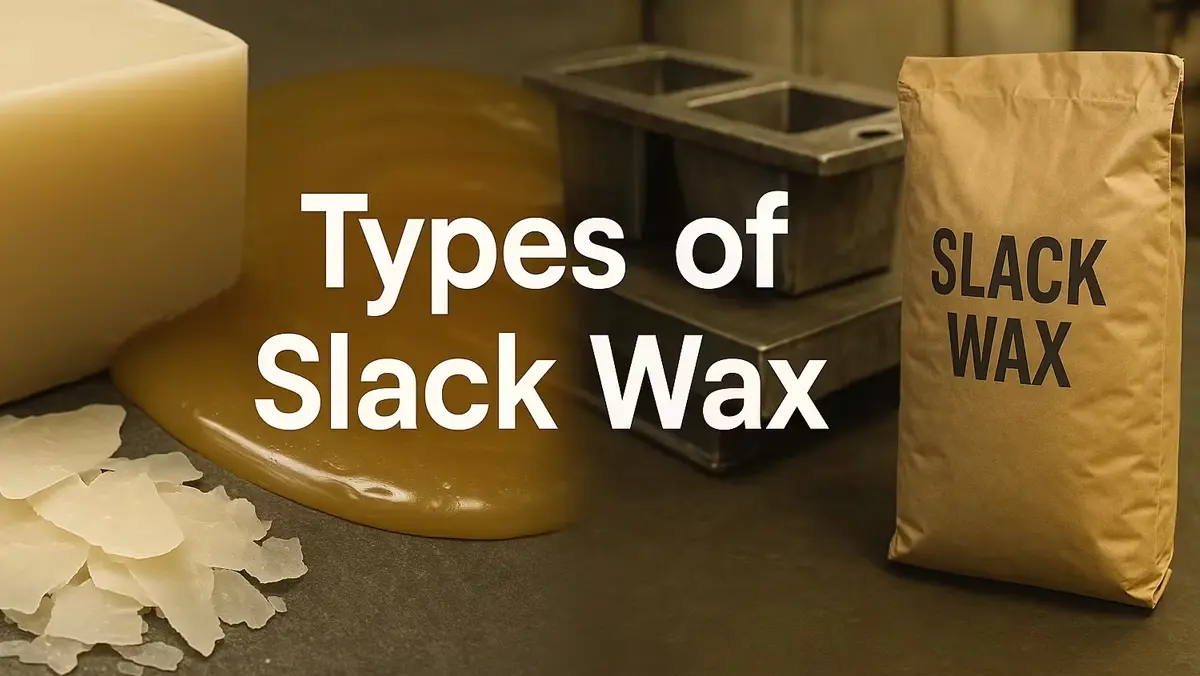
Light Slack Wax
- Oil Content: 5–10%
- Color: Light yellow
- Melting Point: Lower (around 45–55°C)
- Texture: Soft and more refined
- Applications:
- Candle manufacturing
- Cosmetic and packaging industries
- Used as a direct or semi‑refined product for high‑purity waxes
Light Slack Wax is preferred when clean burning and bright color are required. Its low oil content makes it a good raw material for converting into fully refined or paraffin wax.
Heavy Slack Wax
- Oil Content: 25–35%
- Color: Brown or dark yellow
- Melting Point: Slightly higher (55–68°C) due to heavy fractions
- Texture: Sticky or semi‑liquid at room temperature
- Applications:
- Rubber and tire manufacturing
- Rust‑preventive coatings
- Industrial lubricants and wood treatment
Heavy Slack Wax offers better adhesion and flexibility in coatings and blends. It is often used when oil retention and moisture resistance are more important than appearance.
In summary, Light Slack Wax is cleaner and used for refinement, while Heavy Slack Wax finds its place in protective and lubrication applications. Choosing the right type depends on the required performance and production process.
Main Industrial Applications
Slack Wax plays a crucial role in many industrial sectors because of its unique blend of solid hydrocarbons and residual oil. Its semi‑refined nature makes it cost‑effective and versatile for use in both raw form and as a base material for further processing.
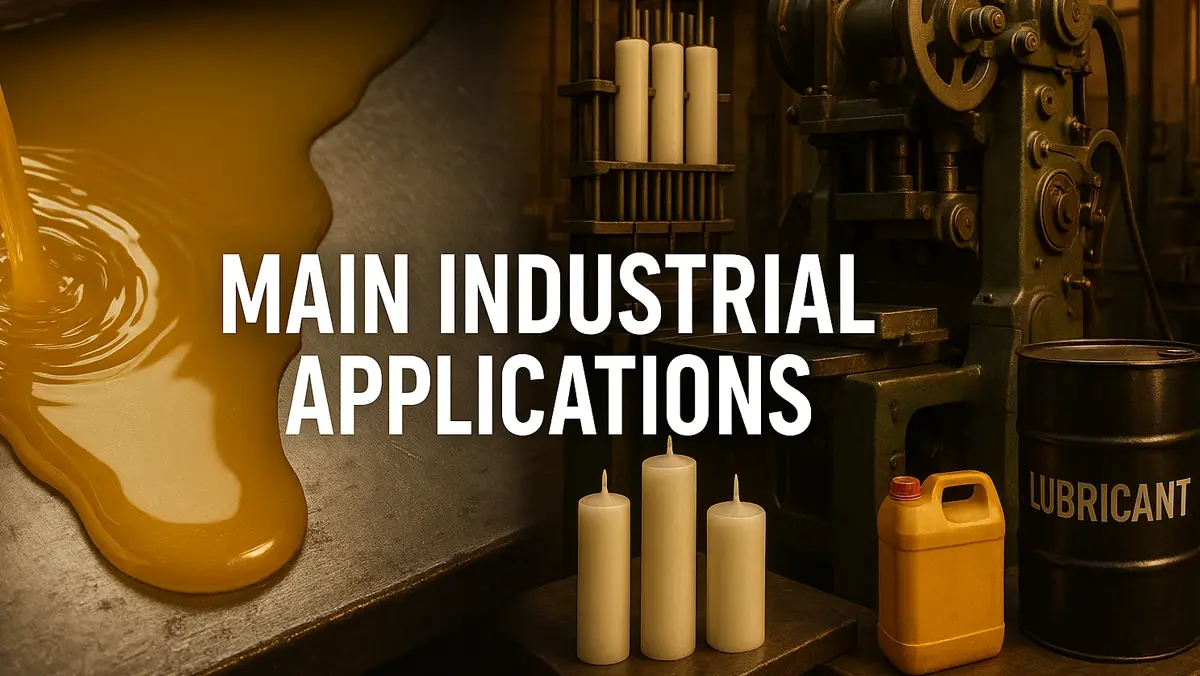
Major Applications
- Candle ManufacturingSlack Wax is commonly used as a feedstock for paraffin wax in candle production. It helps enhance burn time and improve surface smoothness.
- Rubber and Tire IndustryIt acts as a softener and protecting agent, improving flexibility and reducing cracking during high‑temperature operations.
- Wood and MDF ProductionUsed as a water‑repellent in composite wood boards, MDF, and particleboard. It protects materials from moisture absorption and swelling.
- Lubricants and GreasesSlack Wax serves as a carrier and thickening agent in lubricants. Its oil portion provides smoothness and oxidation resistance.
- Rust‑Preventive CoatingsHeavy grades with higher oil levels are ideal for anti‑corrosion coatings, giving long‑lasting protection to metal surfaces.
- Textiles and LeatherActs as a finishing and softening agent, increasing flexibility and giving treated fabrics a smooth texture.
- Adhesives and SealantsProvides stickiness and oil compatibility in various industrial adhesives and sealing compounds.
- Polishes and EmulsionsSlack Wax contributes to shine and viscosity control in floor polishes, furniture waxes, and emulsions.
- Intermediate for Paraffin RefiningPerhaps its most significant use — Slack Wax is the primary raw material for producing fully refined and semi‑refined paraffin waxes widely used in cosmetics and packaging.
Environmental & Modern Trends (2025)
In 2025, industries are increasingly focusing on cleaner refining techniques and recyclable waxes. Sustainable solvents, closed process loops, and energy‑efficient reactors have become standard to reduce waste and improve the environmental profile of Slack Wax derivatives.
Refining Process & Innovations
The refining of Slack Wax transforms it from a semi‑refined byproduct into fully refined paraffin wax suitable for high‑grade industrial and consumer applications. The process generally involves several purification steps designed to remove excess oil, odors, and color impurities while improving oxidation stability.
Main Refining Stages
- Solvent De‑oilingSlack Wax is mixed with specific solvents such as MEK‑toluene blend to dissolve and extract excess oil. Through cooling and filtration, the remaining solid material achieves a lower oil content.
- Vacuum DistillationThe wax is vacuum‑distilled to separate lighter hydrocarbons and enhance purity. This step improves the melting point and ensures uniform composition.
- Hydro‑Finishing (Hydrotreatment)The product undergoes mild hydrogenation under controlled pressure and temperature. Hydrogen reacts with sulfur and nitrogen compounds to form harmless gases, removing color and odor impurities.
- Closed‑Loop Solvent RecoveryModern refineries reuse solvents through automated recovery systems, reducing both energy consumption and environmental waste.
- Quality StabilizationFinal filtration, cooling, and stabilization ensure consistent texture, color, and hardness, preparing the wax for packaging or further processing.
Technological Innovations
Modern Slack Wax refining has adopted several innovations:
- AI‑controlled production systems monitor temperature and flow rates to maximize yield.
- Hybrid reactors combining solvent de‑oiling and hydro‑finishing reduce energy loss.
- Introduction of low‑emission furnaces compliant with international green regulations.
- Digital quality tracking systems for continuous product analysis and certification.
These advancements ensure lower carbon footprints and uniform results, vital for industries moving toward sustainability in 2025 and beyond.
Quality Factors & Standards
The quality of Slack Wax is determined by several physical and chemical properties that define its usability and refining potential. Since Slack Wax is a semi‑refined product, maintaining consistency across batches is crucial for industrial producers.
Main Quality Parameters
- Melting Point Test: Ensures uniform behavior during melting and solidifying. Typical range is 45°C–68°C depending on grade.
- Oil Content Measurement: High oil content provides flexibility, while low oil content increases purity and hardness. Values are checked with standard ASTM testing methods.
- Color and Appearance: Lighter color indicates lower impurities and better refining; darker tone means higher oil levels or crude origin variations.
- Viscosity and Hardness: Measured to ensure compatibility in lubricants or coatings.
- Flash Point & Odor: Determines stability under heat and exposure to air, important in candle and polish industries.
- Water Content: Any trace moisture can affect emulsions and coating quality, so strict dehydration is required.
Control and Certification Standards
To guarantee product reliability, Slack Wax producers adhere to international certification systems such as:
- ASTM D721/D3236 for melting and oil content tests
- ISO 2207/2329 for wax viscosity and chemical purity
- REACH and EPA guidelines limiting sulfur and hydrocarbon emissions during refining
Compliance with these standards ensures safe handling, stable product behavior, and environmental protection.
Industrial Quality Practices
By 2025, most refineries have introduced digital quality management systems to track every batch in real time, ensuring uniform composition and traceability. Automated testing and sustainability audits have become mandatory in large-scale operations across Europe and Asia.
Differences from Paraffin Wax
Although Slack Wax and Paraffin Wax come from similar refining origins, they have unique properties that define their industrial roles.
Slack Wax is a semi‑refined wax containing a high oil content, while Paraffin Wax is fully refined and purer with less oil and impurities.
Comparison Table
| Property | Slack Wax | Paraffin Wax |
|---|---|---|
| Refining Level | Semi‑refined, still contains oils | Highly refined, almost pure hydrocarbons |
| Oil Content (%) | 5%–35% | 0.5%–3% |
| Color | Yellow to brown | White to translucent |
| Texture | Soft and pliable | Hard and brittle |
| Melting Point (°C) | 45–68 | 50–75 |
| Impurities | Higher, contains sulfur or nitrogen traces | Minimal, clean and odorless |
| Price | Lower | Higher |
| Main Uses | Raw material for refining, lubrication, industrial coatings | Candles, pharmaceuticals, cosmetics, food-grade applications |
Key Functional Differences
- Slack Wax serves as a base feedstock for refining into fully purified waxes.
- Paraffin Wax is a final commercial product, ready for use in industries that demand colorless and odor-free materials.
- Due to its higher oil content, Slack Wax offers smoother surface coating and water resistance, ideal for particleboards and anti-corrosion coatings.
- Paraffin Wax, being harder and cleaner, works better for premium candles and packaging.
Economic Perspective
In 2025, Slack Wax remains a cost‑effective raw material with broader industrial flexibility, whereas Paraffin Wax dominates consumer-grade markets requiring consistent appearance and purity.
Key Takeaways
- Slack Wax is a semi‑refined by‑product obtained during base‑oil de‑waxing, containing 5–35% oil and long‑chain hydrocarbons.
- Its composition and melting behavior make it ideal as a raw material for paraffin and industrial lubricants.
- The refining process involves solvent de‑oiling, vacuum distillation, and hydro‑finishing — increasingly optimized through AI‑based efficiency systems.
- Key quality factors include melting point, oil content, color, and viscosity, with compliance to strict ASTM and ISO standards.
- Light Slack Wax (low‑oil, higher purity) differs from Heavy Slack Wax (higher‑oil, better coating strength).
- Industrial uses cover candles, tires, wood boards, corrosion‑resistant coatings, lubricants, and paraffin feedstock.
- In 2025, market value is estimated near USD 4 billion, led by Asian and Middle‑Eastern refiners adopting greener processing technologies.
Overall, Slack Wax remains a cost‑efficient and adaptable product that combines chemical reliability with environmental compatibility. Its versatility — from candle manufacturing to industrial lubrication — ensures continuous relevance in sustainable wax production and positions it as a strategic link between crude‑oil derivatives and advanced eco‑wax formulations.


